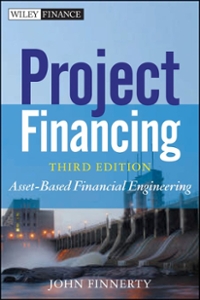Can you explain why we ignored the 6% interest rate when calculating NPV & why we took the Fixed cost net of tax to calculate NPV? is there a mistake in the solution ? please explain in details as im confused.

QUESTIONS: Toronto Corporation is considering a 5 year project involving the production of portable hard drives. The project requires the following immediate investment: land 800.000, net working capital S70,000, and 10 machines used in production will cost $40.000 per machine. The firm will borrow the entire initial investment at an interest rate of 6% and pay back the principal at the end of the project In the first year, each machine is expected to produce 3,500 hard drives. The sales department is forecasting that all units produced each year will be sold, and they will be sold at 555 per unit. In each subsequent year, unit sales are expected to increase by 4%. Variable costs will be 40% of the unit price and the annual fixed costs of the project is $1,000,000. The firm expects to be able to sell the land and all of these machines at the end of the project for $800,000 and $200,000, respectively. (Note: The pool will continue for machines relating to other projects that the company has). The machines are subject to a CCA rate of 25%. The land cannot be amortized for tax purposes The firm's tax rate is 35%, and the cost of capital is 12% Calculate the NPV of this project. Is the project recommended according to the NPV rule? Solution: Initial costs (1) PV of gross profit (2) PV of fixed costs (2) PV of ending cash flows (3) PV of CCA tax shield (4) NPV -1,270,000 2,905.763 -2.343.104 607,147 62.689 -37.505 Therefore do NOT invest in this project because the NPV is negative. WORKINGS: Initial costs: Land: Working capital: Machines $800,000 70,000 400,000 1270,000 10 Sales and operating profit: Year 1: 3,500 x $55 - $192,500 per machine So, 10 machines 192,500 x 10 $1.925.000 Sales and operating profit Year 1: 3,500 x $55 - $192,500 per machine So, 10 machines = 192,500 x 10 = $1,925.000 Variable costs = 40% So gross profit before fixed costs = 60% x $1,925.000 = $1,155,000 After tax: $1,155,000 x (1 -0.35) = $750,750 (increases by 4% per year) PV of gross profit-treat as a growing annuity: c PV - [750,000/(0.12 -0.04)] x [1 - {(1.04/1.12)"}] = 2,905,763 PV of fixed costs: treat as an annuity for 5 yrs PMT = $1,000,000 => after tax = 1.000.000 X (1-0.35) =650.000 n-5yrs FV=0 Using a financial calculator: PV = 2,343,104 PV of salvage value an ending working capital: (i.e. ending cash flow) Land 800,000 Machines 200,000 Working capital 70,000 1.070.000 PV = 1.070.000/(1.125) = 607.147 PV of CCA tax shield: You only get the CCA deduction on the machines: PV = [(400,000x 0.25 x 0.357(0.12 +0.25)[1+0.5x0.1291.12] - [(200,000x 0.25 0.35)(0.12+0.25)][1+(1/(1.12)] 62,689









